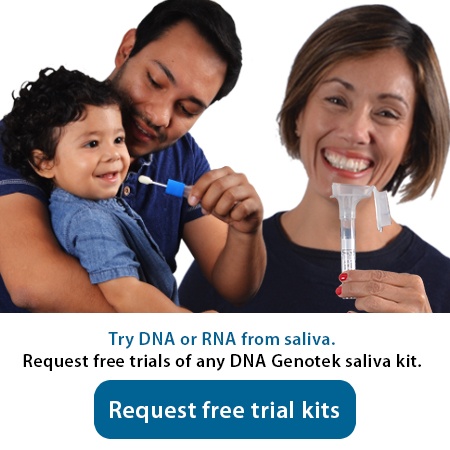Will Genes for Good Take Samples Again
2018-x-09
Genetic epidemiology, the study of how genetics contribute to health and disease in families and populations, seeks to derive a statistical assay of how genetics works in large groups. Information technology therefore requires enough Deoxyribonucleic acid samples from a given population to reduce the effect of outliers and ultimately, determine objective truths. The more samples that are required, the more circuitous and costly the study. Researchers are taxed with finding the right sample size and report blueprint to demonstrate credibility without breaking their budgets. Dna Genotek has extensive experience working with genetic researchers over the past 15 years on both sample and study management. In working with researchers conducting a wide spectrum of projects, we take observed the post-obit summit ten essential considerations when designing and executing big-calibration sample collection for genetic enquiry. Dna collection needs to be fast, easy and painless to maximize donor compliance and accomplish large sample cohorts. Compliance can be augmented by tailoring collection instructions (i.e. larger font, simplified language), offering translations and/or incorporating how to videos. Some collection scenarios may likewise benefit from offering assisted or supervised sampling. Saliva is a proven method to easily collect large amounts of Deoxyribonucleic acid that performs equivalent to claret in downstream analysis (when stabilized to maintain loftier molecular weight). In large-scale sampling, recruitment is key. The easiest way to recruit large numbers is to collect where your donors are - in a dispensary, in a remote field location, at an event or in the comfort of their own home. The sample drove procedure must be optimized to achieve your donor population in their setting. For example, sample kits may require custom configurations (ex. family unit vs. individual drove, child vs. adult), assembly, tracking, shipping and/or storage capacity. To avoid the cost of a warehouse functioning, consider outsourcing to a company to handle these assembly and logistical demands. Engage your donors. Explain the purpose of your research and how donors will help you lot achieve these goals. Offer incentives when necessary to further motivate donors. Market your written report. Give your project a name and a brand - develop imagery to reflect your unique mission. Create a collection bundle (i.e. sample kit(s), user instructions, and other support material) that positively engages the donor and reflects the goals of your written report. Consider creating a project website where donors can acquire, sign up to participate and request their own DNA sample drove package. Evaluate sample drove methods with your written report population at every collection site. Identify high-take chances sub-populations and make up one's mind the collection method that accommodates all donors. Ensure drove instructions are communicated and followed. A critical cistron in any study, regardless of size, is the quality and reproducibility of results. Sample integrity at the betoken of collection sets the limits for assay downstream. Maintaining sample integrity through transport, storage and processing is equally critical in producing reliable results. Select a sample method that ensures that loftier quality DNA is immediately stabilized and protected until laboratory processing. An increasing number of labs and studies are moving to sequencing platforms – which are significantly more circuitous than PCR and SNP genotyping. These platforms require DNA of high molecular weight. To salve time, money, and complication during send to the processing laboratory, choose a collection method that stabilizes Dna at ambient temperature. Consider efficient outer packaging to reduce shipping costs and ensure your samples accept the appropriate regulatory clearances to send hands, whether nationally or internationally. Be prepared to reference the collection, transfer, receipt, analysis, storage and disposal of all samples. Barcodes for donor traceability offers a scalable solution and they should be placed on sample vials as well every bit whatsoever connected paperwork. Consider a sample type that can integrate easily into automatic high-throughput processing for rapid downstream analysis. Long-term DNA stabilization is disquisitional when considering how and where to shop your unprocessed samples. Ambient temperature storage does not require freezer space and is very cost constructive. Enquire for assistance. Select a supplier that has process, quality and regulatory experience to guide you lot through best practices and attain your study results. Dna Genotek specializes in sample management – from study blueprint and logistics, piece of cake sample collection, firsthand sample stabilization, efficient transport/storage and sample processing, to comprehensive lab services and interpretation. Researchers looking for expertise and support in big-calibration sample drove, tin can find proven solutions with Deoxyribonucleic acid Genotek. Optimizing genetic samples from drove to analysis will enable highly efficient study management and strong downstream analytics.
ane. Non-invasive, easy collection increases compliance.
2. Accessible donation maximizes recruitment.
three. Motivated donors donate.
4. Enquiry that looks important gains importance.
5.Standardized collection delivers consequent and reliable results.
6. High quality samples accomplish high quality results.
7. Sample transportation can exist fast, affordable and easy.
8. Stiff sample traceability delivers integrity and accountability.
ix. Scalable laboratory technique ability efficiency.
10. Inquiry is collaborative.

Source: https://blog.dnagenotek.com/how-to-execute-large-scale-dna-sample-collection-for-genetic-research-10-essential-considerations
Post a Comment for "Will Genes for Good Take Samples Again"